Ashanti Empire
The Asante Empire (Asante Twi: Asanteman) was an Akan empire and kingdom from 1701 to 1957, in what is now modern-day Ghana. It expanded from Ashanti to include the Brong-Ahafo Region, Central Region, Eastern Region, Greater Accra Region and Western Region of present-day Ghana. Due to the empire's military prowess, wealth, architecture, sophisticated hierarchy and culture, the Ashanti Kingdom has been extensively studied and has more books written by European, primarily British authors than any other indigenous culture of Sub-Saharan Africa.[4]
Kingdom of Ashanti Asanteman (Asante Twi) | |||||||||||||
|---|---|---|---|---|---|---|---|---|---|---|---|---|---|
| 1670/1701–1902 1935–1957 | |||||||||||||
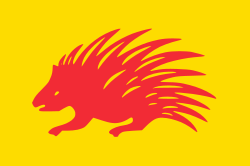 National Emblem
| |||||||||||||
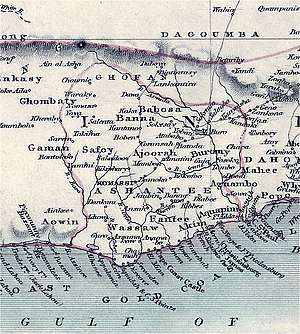 Map of the Kingdom of Ashanti | |||||||||||||
| Status | State union | ||||||||||||
| Capital | Kumasi | ||||||||||||
| Common languages | Ashanti (Twi) (official) | ||||||||||||
| Religion | Initially Akan religion, later also Christianity | ||||||||||||
| Government | Monarchy | ||||||||||||
• 1670–1717 (first king) | Osei Tutu | ||||||||||||
• 1888–1896 (13th king of the indep. Ashanti Kingdom) | Prempeh I | ||||||||||||
• 1931–1957 (last king of the indep. Ashanti Kingdom) | Prempeh II | ||||||||||||
| Osei Tutu II | |||||||||||||
| Legislature | Asante Kotoko (Council of Kumasi)[1] and the Asantemanhyiamu (National Assembly) | ||||||||||||
| History | |||||||||||||
• Established | 1670/1701 | ||||||||||||
• Independence from Denkyira | 1701 | ||||||||||||
• Annexed to form a British colony named Ashanti | 1901[2] | ||||||||||||
• Self-Rule | 1935 | ||||||||||||
• State union as Ashanti Region with Ghana | 1957 | ||||||||||||
• State union | Present | ||||||||||||
| Area | |||||||||||||
| [3] | 259,000 km2 (100,000 sq mi) | ||||||||||||
| Population | |||||||||||||
• [3] | 3,000,000 | ||||||||||||
| Currency |
| ||||||||||||
| |||||||||||||
| Today part of | Ghana | ||||||||||||
Starting in the late 17th century, the Ashanti king Osei Tutu (c. 1695 – 1717) and his adviser Okomfo Anokye established the Ashanti Kingdom, with the Golden Stool of Asante as a sole unifying symbol. Osei Tutu oversaw a massive Ashanti territorial expansion, building up the army by introducing new organisation and turning a disciplined royal and paramilitary army into an effective fighting machine.[4] In 1701, the Ashanti army conquered Denkyira, giving the Ashanti access to the Gulf of Guinea and the Atlantic Ocean coastal trade with Europeans, notably the Dutch.[4]
The Ashanti Empire fought several wars with neighboring kindgoms and lesser organized tribes such as the Fante. The Ashanti defeated the British Empire's invasions in the first two of the four Anglo-Ashanti Wars, killing and keeping British army general Sir Charles MacCarthy's skull as a gold-rimmed drinking cup in 1824. Due to British improvements in weapons technology, burning and looting of the capital Kumasi and final defeat at the fifth Anglo-Ashanti War, the Ashanti empire became part of the Gold Coast colony in January 1, 1902.
Today, the Ashanti Kingdom survives as a constitutionally protected, sub-national traditional state[5] in union with the Republic of Ghana. The current king of the Ashanti Kingdom is Otumfuo Osei Tutu II Asantehene. The Ashanti Kingdom is the home to Lake Bosumtwi, Ghana's only natural lake. The state's current economic revenue is derived mainly from trading in gold bars, cocoa, kola nuts and agriculture.[6]
Etymology and origins

The name Asante means "because of war". The word derives from the Twi words ɔsa meaning "war" and nti meaning "because of". This name comes from the Asante's origin as a kingdom created to fight the Denkyira kingdom.[7]
The variant name "Ashanti" comes from British reports that transcribing "Asante" as the British heard it pronounced, as-hanti. The hyphenation was subsequently dropped and the name Ashanti remained, with various spellings including Ashantee common into the early 20th century.
Between the 10th and 12th centuries AD the ethnic Akan people migrated into the forest belt of Southern Ghana and established several Akan states:
- Ashanti,
- Brong-Ahafo,
- Assin-Denkyira-Fante Confederacy-Mankessim Kingdom (present-day Central region)
- Akyem-Akwamu-Akuapem-Kwahu (present-day Eastern region and Greater Accra), and
- Ahanta-Aowin-Sefwi-Wassa (present-day Western region).
Before the Ashanti Kingdom had contact with Europeans, it had a flourishing trade with other African states due to the Ashanti gold wealth. Trade with European states began after contact with the Portuguese in the 15th century AD.[8] When the gold mines in the Sahel started to play out, the Ashanti Kingdom rose to prominence as the major player in the gold trade.[6] At the height of the Ashanti Kingdom, the Ashanti people became wealthy through the trading of gold mined from their territory.[6]
History
| Gold Coast |
|---|
.svg.png) |
|
Foundation
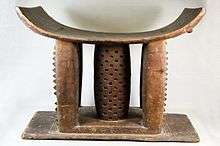
Ashanti political organization was originally centered on clans headed by a paramount chief or Amanhene.[9][10] One particular clan, the Oyoko, settled in the Ashanti's sub-tropical forest region, establishing a center at Kumasi.[11] The Ashanti became tributaries of another Akan state, Denkyira but in the mid-17th century the Oyoko under Chief Oti Akenten started consolidating the Ashanti clans into a loose confederation against the Denkyira.[12]

The introduction of the Golden Stool (Sika dwa) was a means of centralization under Osei Tutu. According to legend, a meeting of all the clan heads of each of the Ashanti settlements was called just prior to declaring independence from Denkyira. In this meeting the Golden Stool was commanded down from the heavens by Okomfo Anokye, chief-priest or sage advisor to Asantehene Osei Tutu I and floated down from the heavens into the lap of Osei Tutu I. Okomfo Anokye declared the stool to be symbolic of the new Asante Union (the Ashanti Kingdom), and allegiance was sworn to the stool and to Osei Tutu as the Asantehene. The newly declared Ashanti union subsequently waged war against and defeated Denkyira.[13] The stool remains sacred to the Ashanti as it is believed to contain the Sunsum — spirit or soul of the Ashanti people.
Independence
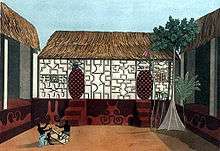
In the 1670s the head of the Oyoko clan, Osei Kofi Tutu I, began another rapid consolidation of Akan peoples via diplomacy and warfare.[14] King Osei Kofu Tutu I and his chief advisor, Okomfo Kwame Frimpong Anokye led a coalition of influential Ashanti city-states against their mutual oppressor, the Denkyira who held the Ashanti Kingdom in its thrall. The Ashanti Kingdom utterly defeated them at the Battle of Feyiase, proclaiming its independence in 1701. Subsequently, through hard line force of arms and savoir-faire diplomacy, the duo induced the leaders of the other Ashanti city-states to declare allegiance and adherence to Kumasi, the Ashanti capital. From the beginning, King Osei Tutu and priest Anokye followed an expansionist and an imperialistic provincial foreign policy. According to folklore, Okomfo Anokye is believed to have visited Agona-Akrofonso.[15]
Under Osei Tutu
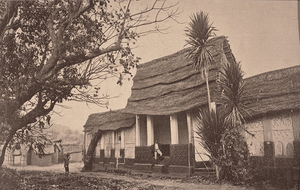
Realizing the strengths of a loose confederation of Akan states, Osei Tutu strengthened centralization of the surrounding Akan groups and expanded the powers of the judiciary system within the centralized government. This loose confederation of small city-states grew into a kingdom and eventually an empire looking to expand its borders. Newly conquered areas had the option of joining the empire or becoming tributary states.[16] Opoku Ware I, Osei Tutu's successor, extended the borders, embracing much of Ghana's territory.[17]
European contact
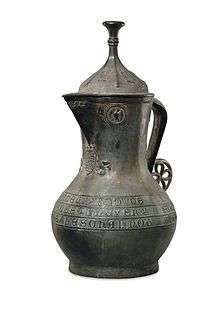
European contact with the Asante on the Gulf of Guinea coast region of Africa began in the 15th century. This led to trade in gold, ivory, slaves, and other goods with the Portuguese, which gave rise to kingdoms such as the Ashanti. On May 15, 1817 the Englishman Thomas Bowdich entered Kumasi. He remained there for several months, was impressed, and on his return to England wrote a book, Mission from Cape Coast Castle to Ashantee.[18] His praise of the kingdom was disbelieved as it contradicted prevailing prejudices. Joseph Dupuis, the first British consul in Kumasi, arrived on March 23, 1820. Both Bowdich and Dupuis secured a treaty with the Asantehene. But, the governor, Hope Smith, did not meet Ashanti expectations.[19]
Slavery
Slavery was historically a tradition in the Ashanti Empire, with slaves typically taken as captives from enemies in warfare. The welfare of their slaves varied from being able to acquire wealth and intermarry with the master's family to being sacrificed in funeral ceremonies. The Ashanti believed that slaves would follow their masters into the afterlife. Slaves could sometimes own other slaves, and could also request a new master if the slave believed he or she was being severely mistreated.[20][21]
The modern-day Ashanti claim that slaves were seldom abused,[22] and that a person who abused a slave was held in high contempt by society. They defend the "humanity" of Ashanti slavery by noting that those slaves were allowed to marry, and that their children were born free.[15] If a master found a female slave desirable, he might marry her. He preferred such an arrangement to that of a free woman in a conventional marriage, because marriage to an enslaved woman allowed the children to inherit some of the father's property and status.
This favored arrangement occurred primarily because of what some men considered their conflict with the matrilineal system. Under this kinship system, children were considered born into the mother's clan and took their status from her family. Generally her eldest brother served as mentor to her children, particularly for the boys. She was protected by her family. Some Ashanti men felt more comfortable taking a slave girl or pawn wife in marriage, as she would have no abusua (older male grandfather, father, uncle or brother) to intercede on her behalf when the couple argued. With an enslaved wife, the master and husband had total control of their children, as she had no kin in the community.
British relations
In December 1895, the British left Cape Coast with an expeditionary force. It arrived in Kumasi in January 1896 under the command of Robert Baden-Powell.[23] The Asantehene (king) directed the Ashanti to not resist, as he feared a genocide. Shortly thereafter, Governor William Maxwell arrived in Kumasi as well.
Britain annexed the territories of the Ashanti and the Fanti and constituted the Ashanti Crown Colony on 26 September 1901.[2] Asantehene Agyeman Prempeh was deposed and arrested, and he and other Ashanti leaders were sent into exile in the Seychelles. The Asante Union was dissolved. A British Resident was permanently placed in the city of Kumasi, and soon after a British fort was built there.
Uprisings of 1900 and since 1935
As a final measure of resistance, the remaining Asante court not exiled to the Seychelles mounted an offensive against the British Residents at the Kumasi Fort. The resistance was led by Asante queen Yaa Asantewaa, Queen-Mother of Ejisu. From March 28 to late September 1900, the Asante and British were engaged in what would become known as the War of the Golden Stool. In the end, the British were victorious; they exiled Asantewaa and other Asante leaders to the Seychelles to join Asante King Prempeh I.
In January 1902, Britain finally designated the Ashanti Kingdom as a protectorate. the Ashanti Kingdom was restored to self-rule on 31 January 1935. Asante King Prempeh II was restored in 1957, and the Ashanti Kingdom entered a state union with Ghana on independence from the United Kingdom.
Territorial history timeline

Government and politics
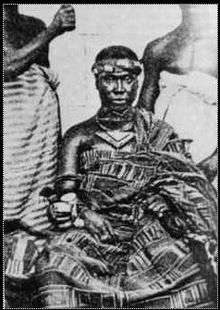
The Ashanti government was built upon a sophisticated bureaucracy in Kumasi, with separate ministries to handle the state's affairs.[24] Of particular note was Ashanti's Foreign Office based in Kumasi; despite its small size, it allowed the state to pursue complex negotiations with foreign powers. The Office was divided into departments to handle relations separately with the British, French, Dutch, and Arabs. Scholars of Ashanti history, such as Larry Yarak and Ivor Wilkes, disagree over the power of this sophisticated bureaucracy in comparison to the Asantehene, but agree that it was a sign of a highly developed government with a complex system of checks and balances.
Asantehene
At the top of Ashanti's power structure sat the Asantehene, the King of Ashanti. Each Asantahene was enthroned on the sacred Golden Stool, the Sika 'dwa, an object that came to symbolise the very power of the King. Osei Kwadwo (1764–1777) began the meritocratic system of appointing central officials according to their ability, rather than their birth.[25]
As King, the Asantehene held immense power in Ashanti, but did not enjoy absolute royal rule.[26][27] He was obliged to share considerable legislative and executive powers with Asante's sophisticated bureaucracy. But the Asantehene was the only person in Ashanti permitted to invoke the death sentence in cases of crime. During wartime, the King acted as Supreme Commander of the army, although during the 19th century, the fighting was increasingly handled by the Ministry of War in Kumasi. Each member of the confederacy was also obliged to send annual tribute to Kumasi.
The Ashantihene (King of all Ashanti) reigned over all and was King of the division of Kumasi, the nation's capital, and the Ashanti Kingdom. He was elected in the same manner as all other chiefs. In this hierarchical structure, every chief or King swore fealty to the one above him—from village and subdivision, to division, to the chief of Kumasi, and finally the Ashantihene swore fealty to the State.[28]
The elders circumscribed the power of the Ashantihene, and the chiefs of other divisions considerably checked the power of the King. This in practical effect created a system of checks and balances. As the symbol of the nation, the Ashantihene received significant deference ritually, for the context was religious in that he was a symbol of the people in the flesh: the living, dead or yet to be born. When the king committed an act not approved of by the counsel of elders or the people, he could possibly be impeached, and demoted to a commoner.
The existence of aristocratic organizations and the council of elders is evidence of an oligarchic tendency in Ashanti political life. Though older men tend to monopolize political power, Ashanti instituted an organization of young men, the nmerante, that tend to democratize and liberalize the political process. The council of elders undertake actions only after consulting a representative of the nmerante. Their views must be taken seriously and added into the conversation.
Obirempon
Below the Asantahene, local power was invested in the obirempon of each locale. The obirempon (literally "big man") was personally selected by the Asantahene and was generally of loyal, noble lineage, frequently related to the Asantahene. Obirempons had a fair amount of legislative power in their regions, more than the local nobles of Dahomey but less than the regional governors of the Oyo Empire. In addition to handling the region's administrative and economic matters, the obirempon also acted as the Supreme Judge of the region, presiding over court cases.
Residence
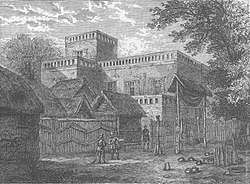
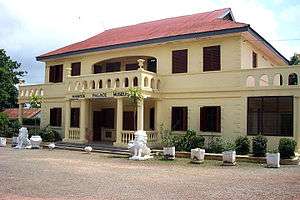
The current residence of the Asantehene is the Manhyia Palace built in 1925 by the British and presented to the Prempeh I as a present upon his return from exile.
The original palace of the Asantehene in Kumasi was burned down by the British in 1875. From European accounts, the edifice was massive and ornately built. In 1819, English traveler and author, Thomas Edward Bowdich described the palace as
...an immense building of a variety of oblong courts and regular squares [with] entablatures exuberantly adorned with bold fan and trellis work of Egyptian character. They have a suite of rooms over them, with small windows of wooden lattice, of intricate but regular carved work, and some have frames cased with thin gold. The squares have a large apartment on each side, open in front, with two supporting pillars, which break the view and give it all the appearance of the proscenium or front of the stage of the older Italian theaters. They are lofty and regular, and the cornices of a very bold cane-work in alto-relievo. A drop-curtain of curiously plaited cane is suspended in front, and in each, we observed chairs and stools embossed with gold, and beds of silk, with scattered regalia.[29]
Winwood Reade also described his visit to the Ashanti Royal Palace of Kumasi in 1874: “We went to the king’s palace, which consists of many courtyards, each surrounded with alcoves and verandahs, and having two gates or doors, so that each yard was a thoroughfare . . . But the part of the palace fronting the street was a stone house, Moorish in its style . . . with a flat roof and a parapet, and suites of apartments on the first floor. It was built by Fanti masons many years ago. The rooms upstairs remind me of Wardour Street. Each was a perfect Old Curiosity Shop. Books in many languages, Bohemian glass, clocks, silver plate, old furniture, Persian rugs, Kidderminster carpets, pictures and engravings, numberless chests and coffers. A sword bearing the inscription From Queen Victoria to the King of Ashantee. A copy of the Times, 17 October 1843. With these were many specimens of Moorish and Ashanti handicraft.”
_p338_PLATE_5_-_COOMASSIE%2C_ODUMATA'S_SLEEPING_ROOM.jpg) Odumata's Sleeping Room (1819).
Odumata's Sleeping Room (1819)._p341_PLATE_7_-_COOMASSIE%2C_PART_OF_A_PIAZZA_IN_THE_PALACE.jpg) Piazza in the Palace (1819).
Piazza in the Palace (1819)._p344_PLATE_9_-_COOMASSIE%2C_PART_OF_ADAM_STREET.jpg) Adam Street (1819).
Adam Street (1819).
Elections
_p341_PLATE_8_-_COOMASSIE%2C_PART_OF_A_PIAZZA_IN_THE_PALACE.jpg)
The election of Kings and the Asantehene (King of Kings or emperor ) himself followed a pattern. The senior female of the kingly lineage nominated the eligible males. This senior female then consulted the elders, male and female, of that line. The final candidate is then selected. That nomination is then sent to a council of elders, who represent other lineages in the town or district. The Elders then present the nomination to the assembled people.
If the assembled citizens disapprove of the nominee, the process is restarted. Chosen, the new Kings is en-stooled by the Elders, who admonish him with expectations. The chosen Kings swears a solemn oath to the Earth Goddess and to his ancestors to fulfill his duties honorably in which he "sacrifices" himself and his life for the betterment of the Oman/Aman (state(s).
This elected and en-stooled King enjoys a great majestic ceremony to this day with much spectacle and celebration. He reigns with much despotic power, including the ability to make judgments of life and death on his subjects. However, he does not enjoy absolute rule. Upon the stool, the King is sacred, the holy intermediary between people and ancestors. His powers theoretically are more apparent than real. His powers hinge on his attention to the advice and decisions of the Council of Elders. The King can be impeached, de-stooled (de-throned), if the Elders and the people turn against him. He can be reduced to man, subject to derision for his failure.
Legal system
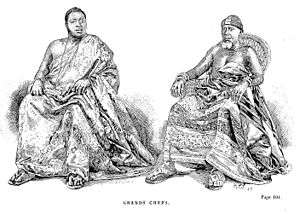
The Ashanti state, in effect, was a theocracy. It invokes religious, rather than secular-legal postulates. What the modern state views as crimes, Ashanti view practically as sins. Antisocial acts disrespect the ancestors, and are only secondarily harmful to the community. If the chief or King fails to punish such acts, he invokes the anger of the ancestors and the gods, and is therefore in danger of impeachment. The penalty for some crimes (sins) is death, but this is seldom imposed; a more common penalty is banishment or imprisonment.
The King typically exacts or commutes all capital cases. These commuted sentences by King and chiefs sometimes occur by ransom or bribe; they are regulated in such a way that they should not be mistaken for fines, but are considered as revenue to the state, which for the most part welcomes quarrels and litigation. Commutations tend to be far more frequent than executions.
Ashanti are repulsed by murder, and suicide is considered murder. They decapitate those who commit suicide, the conventional punishment for murder. The suicide thus had contempt for the court, for only the King may kill an Ashanti.
In a murder trial, intent must be established. If the homicide is accidental, the murderer pays compensation to the lineage of the deceased. The insane cannot be executed because of the absence of responsible intent - except for murder or cursing the King; in the case of cursing the king, drunkenness is a valid defense. Capital crimes include murder, incest within the female or male line, and intercourse with a menstruating woman, rape of a married woman, and adultery with any of the wives of a chief or the King. Assaults or insults of a chief or the court or the King also carried capital punishment.
Cursing the King, calling down powers to harm the King, is considered an unspeakable act and carries the weight of death. One who invokes another to commit such an act must pay a heavy indemnity. Practitioners of harmful (evil) forms of sorcery and witchcraft receive death but not by decapitation, for their blood must not be shed. They receive execution by strangling, burning, or drowning.
Ordinarily, families or lineages settle disputes between individuals. Nevertheless, such disputes can be brought to trial before a chief by uttering the taboo oath of a chief or the King. In the end, the King's Court is the sentencing court, for only the King can order the death penalty. Before the Council of Elders and the King's Court, the litigants orate comprehensively. Anyone present can cross-examine the defendant or the accuser, and if the proceedings do not lead to a verdict, a special witness is called to provide additional testimony. If there is only one witness, their sworn oath assures the truth is told. Moreover, that he favors or is hostile to either litigant is unthinkable. Cases with no witness, like sorcery or adultery are settled by ordeals, like drinking poison.
Ancestor Veneration establishes the Ashanti moral system, and it provides the principal foundation for governmental sanctions. The link between mother and child centers the entire network, which includes ancestors and fellow men as well. Its judicial system emphasizes the Ashanti conception of rectitude and good behavior, which favors harmony among the people. The rules were made by Nyame (Supreme God) and the ancestors, and one must behave accordingly.
Geography

The Ashanti Empire was one of a series of kingdoms along the coast including Dahomey, Benin, and Oyo. The Ashanti Kingdom had mountains and large agricultural surpluses.[3] The southern part of the Ashanti Kingdom is covered with moist semi-deciduous forest whilst the Guinea savanna covers the northern part of the Ashanti Kingdom. The Guinea Savanna consists of short deciduous and fire resistant trees. Riparian forests also occur along the Afram River and streams of the savanna zone. Soils in the Ashanti Kingdom are mainly of two types, forest ochrosols in southern the Ashanti Kingdom whilst the savanna ochrosols are confined to northern the Ashanti Kingdom.[3]
The predominant fauna or food rich wildlife and animal species encountered in the Ashanti Kingdom were the hen, sheep, goat, duck, turkey, rabbit, guinea fowl, fish, and the porcupine which became the national emblem of the Ashanti Kingdom, as well as about thirty multipurpose flora species of trees and shrubs and over thirty-five ornamental plants beautifying the Ashanti Kingdom environs. These tree/shrub-crop-animal (hen/fish) components were intensively integrated spatially and/or sequentially on the same land unit of individual Asante houses.[3]
Economy
Resources
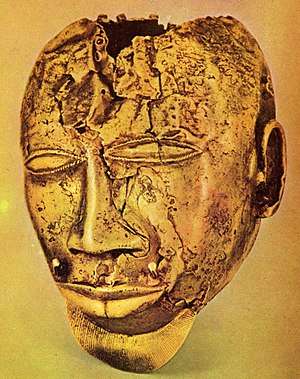
The lands within the Ashanti Kingdom were also rich in river-gold, cocoa and kola nuts, and the Ashanti were soon trading with the Portuguese at coastal fort Sao Jorge da Mina, later Elmina, the Songhai, and with the Hausa states.[30]
Agriculture
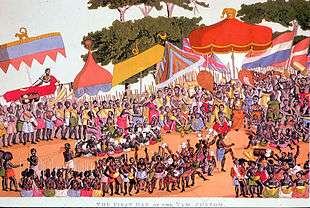
The Ashanti prepared the fields by burning before the onset of the rainy season and cultivated with an iron hoe. Fields are left fallow for a couple years, usually after two to four years of cultivation. Plants cultivated include plantains, yams, manioc, corn, sweet potatoes, millet, beans, onions, peanuts, tomatoes, and many fruits. Manioc and corn are New World transplants introduced during the Atlantic European trade. Many of these vegetable crops could be harvested twice a year and the cassava (manioc), after a two-year growth, provides a starchy root. The Ashanti transformed palm wine, maize and millet into beer, a favorite drink; and made use of the oil from palm for many culinary and domestic uses.
Infrastructure
Infrastructure such as road transport and communication throughout the Ashanti Kingdom was maintained via a network of well-kept roads from the Ashanti Kingdom to the Niger river and other trade cities.[31][32]
Communication

The Ashanti invented the Fontomfrom, an Asante talking drum, and they also invented the Akan Drum. They drummed messages to distances of over 300 kilometres (200 mi), as rapidly as a telegraph. Asante dialect (Twi) and Akan, the language of the Ashanti people is tonal and more meaning is generated by tone.
The drums reproduced these tones, punctuations, and the accents of a phrase so that the cultivated ear hears the entirety of the phrase itself.
The Ashanti readily heard and understood the phrases produced by these "talking drums". Standard phrases called for meetings of the chiefs or to arms, warned of danger, and broadcast announcements of the death of important figures. Some drums were used for proverbs and ceremonial presentations.
Demography
The population history of the Ashanti Kingdom was one of slow centralization. In the early 19th century the Asantehene used the annual tribute to set up a permanent standing army armed with rifles, which allowed much closer control of the Ashanti Kingdom. The Ashanti Kingdom was one of the most centralised states in sub-Saharan Africa. Osei Tutu and his successors oversaw a policy of political and cultural unification and the union had reached its full extent by 1750. It remained an alliance of several large city-states which acknowledged the sovereignty of the ruler of Kumasi and the Ashanti Kingdom, known as the Asantehene. The Ashanti Kingdom had dense populations, allowing the creation of substantial urban centres.[3] The Ashanti controlled over 250,000 square kilometers while ruling approximately 3 million people.[3]
Police and military
Police
The Asantehene inherited his position from his queen mother, and he was assisted at the capital, Kumasi, by a civil service of men talented in trade, diplomacy, and the military, with a head called the Gyaasehene.[31] Men from the Arabian Peninsula, Sudan, and Europe were employed in the Ashanti Kingdom civil service, all of them appointed by the Asantehene.[31] At the capital, Kumasi and in other Ashanti towns, the ankobia or special police were used as the Ashanti Kingdom special forces and bodyguards to the Asantehene, as sources of the Ashanti Kingdom intelligence, and to suppress rebellion.[31] For most of the 19th century and into the 20th century, the Ashanti Kingdom sovereign state remained powerful.[33]
Military
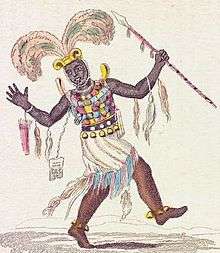
The Ashanti armies served the empire well, supporting its long period of expansion and subsequent resistance to European colonization.
Armament was primarily with firearms, but some historians hold that indigenous organization and leadership probably played a more crucial role in Ashanti successes.[34] These are, perhaps, more significant when considering that the Ashanti had numerous troops from conquered or incorporated peoples, and faced a number of revolts and rebellions from these peoples over its long history. The political genius of the symbolic "golden stool" and the fusing effect of a national army however, provided the unity needed to keep the empire viable. Total potential strength was some 80,000 to 200,000 making the Ashanti army bigger than the well known Zulu, and comparable to possibly Africa's largest- the legions of Ethiopia.[35] The Ashanti army was described as a fiercely organized one whose king could "bring 200,000 men into the field and whose warriors were evidently not cowed by Snider rifles and 7-pounder guns"[36]
While actual forces deployed in the field were less than potential strength, tens of thousands of soldiers were usually available to serve the needs of the empire. Mobilization depended on small cadres of regulars, who guided and directed levees and contingents called up from provincial governors. Organization was structured around an advance guard, main body, rear guard and two right and left wing flanking elements. This provided flexibility in the forest country the Ashanti armies typically operated in. The approach to the battlefield was typically via converging columns, and tactics included ambushes and extensive maneuvers on the wings. Unique among African armies, the Ashanti deployed medical units to support their fighters. This force was to expand the empire substantially and continually for over a century, and defeated the British in several encounters.[35]
Wars of the Asante

From 1806 until 1896, the Ashanti Kingdom was in a perpetual state of war involving expansion or defense of its domain. Ashanti exploits against other African forces made it the paramount power in the region. Its impressive performance against the British also earned it the respect of European powers.
Asante–Fante War
In 1806, the Ashanti pursued two rebel leaders through Fante territory to the coast. The British refusal to surrender the rebels led to an Ashanti attack. This was devastating enough that the British handed over a rebel; the other escaped.[37] In 1807 disputes with the Fante led to the Ashanti–Fante War, in which the Ashanti were victorious under Asantehene Osei Bonsu ("Bonsu, the whale").
Ga–Fante War
In the 1811 Ga–Fante War, a coalition of Asante and Ga fought against an alliance of Fante, Akwapim and Akim states. The Asante war machine was successful early on defeating the alliance in open combat. However, Asante were unable to completely crush their enemies and were forced to withdraw from the Akwapim hills in the face of unconventional warfare. They did, however, manage to capture a British fort.
Ashanti–Akim–Akwapim War
In 1814 the Ashanti launched an invasion of the Gold Coast, largely to gain access to European traders. In the Ashanti–Akim–Akwapim War, the kingdom faced the Akim–Akwapim alliance. After several battles, some of which went in favor of the Asante and, some of which went in favor of the out numbered Akim–Akwapim alliance the war ended. Even though the outnumbered Akim–Akwapim won some key battles and had moments of glory by 1816, the Ashanti Kingdom was established on the coast.
Anglo-Ashanti Wars
First Anglo-Ashanti War

The first of the Anglo-Ashanti wars occurred in 1823. In these conflicts, the Ashanti Kingdom faced off, with varying degrees of success, against the British Empire residing on the coast. The root of the conflict traces back to 1823 when Sir Charles MacCarthy, resisting all overtures by the Ashanti to negotiate, led an invading force. The Ashanti defeated this, killed MacCarthy, took his head for a trophy and swept on to the coast. However, disease forced them back. The Ashanti were so successful in subsequent fighting that in 1826 they again moved on the coast. At first they fought very impressively in an open battle against superior numbers of British allied forces, including Denkyirans. However, the novelty of British rockets caused the Ashanti army to withdraw.[38] In 1831, a treaty led to 30 years of peace, with the Pra River accepted as the border.
Second Anglo-Ashanti War

With the exception of a few Ashanti light skirmishes across the Pra in 1853 and 1854, the peace between the Ashanti Kingdom and the British Empire had remained unbroken for over 30 years. Then, in 1863, a large Ashanti delegation crossed the river pursuing a fugitive, Kwesi Gyana. There was fighting, casualties on both sides, but the governor's request for troops from England was declined and sickness forced the withdrawal of his West Indian troops. The war ended in 1864 as a stalemate with both sides losing more men to sickness than any other factor.
Third Anglo-Ashanti War
In 1869 a European missionary family was taken to Kumasi. They were hospitably welcomed and were used as an excuse for war in 1873. Also, Britain took control of Ashanti land claimed by the Dutch. The Ashanti invaded the new British protectorate. General Wolseley and his famous Wolseley ring were sent against the Ashanti. This was a modern war, replete with press coverage (including by the renowned reporter Henry Morton Stanley) and printed precise military and medical instructions to the troops.[40] The British government refused appeals to interfere with British armaments manufacturers who were unrestrained in selling to both sides.[41]
All Ashanti attempts at negotiations were disregarded. Wolseley led 2,500 British troops and several thousand West Indian and African troops to Kumasi. The capital was briefly occupied. The British were impressed by the size of the palace and the scope of its contents, including "rows of books in many languages."[42] The Ashanti had abandoned the capital after a bloody war. The British burned it.[43]

The British and their allies suffered considerable casualties in the war losing numerous soldiers and high ranking army officers.[44] but in the end the firepower was too much to overcome for the Ashanti. The Asantehene (the king of the Ashanti) signed a British treaty in July 1874 to end the war.
Fourth Anglo-Ashanti War
In 1895, the Ashanti turned down an unofficial offer to become a British protectorate.
The Ashanti Kingdom wanting to keep French and European colonial forces out of the Ashanti Kingdom territory (and its gold), the British were anxious to conquer the Ashanti Kingdom once and for all. Despite being in talks with the kingdom about making it a British protectorate, Britain began the Fourth Anglo-Ashanti War in 1895 on the pretext of failure to pay the fines levied on the Asante monarch after the 1874 war. The British were victorious and the Ashanti Kingdom was forced to sign a treaty.
Culture and society
Family

Standing among families was largely political. The royal family typically topped the hierarchy, followed by the families of the chiefs of territorial divisions. In each chiefdom, a particular female line provides the chief. A committee of several men eligible for the post elects the chief.
Clothing
Education and children

Education in the Ashanti Kingdom was conducted by Asante and imported scholars and Ashanti people would often attend schools in Europe for their higher education.
Tolerant parents are typical among the Ashanti. Childhood is considered a happy time and children cannot be responsible for their actions. The child is not responsible for their actions until after puberty. A child is harmless and there is no worry for the control of their soul, the original purpose of all funeral rites, so the ritual funerals typically given to the deceased Ashanti are not as lavish for the children.
The Ashanti adored twins when they were born within the royal family because they were seen as a sign of impending fortune. Ordinarily, boy twins joined the army and twin girls potential wives of the King. If the twins are a boy and girl, no particular career awaits them. Women who bear triplets are greatly honored because three is regarded as a lucky number. Special rituals ensue for the third, sixth, and ninth child. The fifth child (unlucky five) can expect misfortune. Families with many children are well respected and barren women scoffed at.
Menstruation and impurity
The Ashanti held puberty rites only for females. Fathers instruct their sons without public observance. The privacy of boys was respected in the Ashanti kingdom. As menstruation approaches, a girl goes to her mother's house. When the girl's menstruation is disclosed, the mother announces the good news in the village beating an iron hoe with a stone. Old women come out and sing Bara (menstrual) songs.
Menstruating women suffered numerous restrictions. The Ashanti viewed them as ritually unclean. They did not cook for men, nor did they eat any food cooked for a man. If a menstruating woman entered the ancestral stool (shrine) house, she was arrested, and the punishment could result in death. If this punishment is not exacted, the Ashanti believe, the ghost of the ancestors would strangle the chief. Menstruating women lived in special houses during their periods as they were forbidden to cross the threshold of men's houses. They swore no oaths and no oaths were sworn for or against them. They did not participate in any of the ceremonial observances and did not visit any sacred places.
Healthcare and death
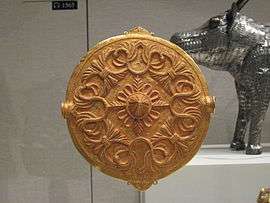
Sickness and death were major events in the kingdom. The ordinary herbalist divined the supernatural cause of the illness and treated it with herbal medicines.
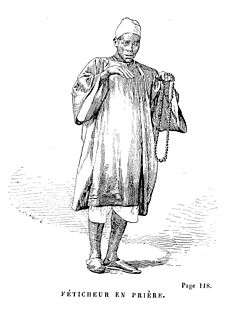
People loathed being alone for long without someone available to perform this rite before the sick collapsed. The family dressed the deceased in their best clothes, and adorned them with packets of gold dust (money for the after-life), ornaments, and food for the journey "up the hill". The body was normally buried within 24 hours. Until that time the funeral party engage in dancing, drumming, shooting of guns, all accompanied by the wailing of relatives. This was done because the Ashanti typically believed that death was not something to be sad about, but rather a part of life. As the Ashanti believed in an after-life, families felt they would be reunited with their ancestors upon death. Funeral rites for the death of a king involved the whole kingdom and were a much more elaborate affair.
Ceremony
The greatest and most frequent ceremonies of the Ashanti recalled the spirits of departed rulers with an offering of food and drink, asking their favor for the common good, called the Adae. The day before the Adae, Akan drums broadcast the approaching ceremonies. The stool treasurer gathers sheep and liquor that will be offered. The chief priest officiates the Adae in the stool house where the ancestors came. The priest offers each food and a beverage. The public ceremony occurs outdoors, where all the people joined the dancing. Minstrels chant ritual phrases; the talking drums extol the chief and the ancestors in traditional phrases. The Odwera, the other large ceremony, occurs in September and typically lasted for a week or two. It is a time of cleansing of sin from society the defilement, and for the purification of shrines of ancestors and the gods. After the sacrifice and feast of a black hen—of which both the living and the dead share—a new year begins in which all are clean, strong, and healthy.
See also
References
- Edgerton, Robert B. Fall of the Asante Empire: The Hundred Year War for Africa's Gold Coast. Free Press, 1995.
- Ashanti Order in Council 1901
- Obeng, J. Pashington (1996). Asante Catholicism: Religious and Cultural Reproduction Among the Akan of Ghana. BRILL. p. 20. ISBN 978-90-04-10631-4.
An empire of a hundred thousand square miles, occupied by about three million people from different ethnic groups, made it imperative for the Asante to evolve sophisticated statal and parastatal institutions [...]
- Collins and Burns (2007), p. 140.
- Roeder, Philip (2007). Where Nation-States Come From: Institutional Change in the Age of Nationalism. Princeton: Princeton University Press. p. 281. ISBN 978-0691134673.
- Collins and Burns (2007), p. 139.
- "Asante – The People Of A Wealthy Gold-Rich Empire – BlackFaces". Retrieved 2020-05-30.
- MacLean, Iain. Rational Choice and British Politics: An Analysis of Rhetoric and Manipulation from Peel to Blair, 2001. Page 76.
- Kings And Queens Of Asante Archived 2012-10-30 at the Wayback Machine
- "Ashanti.com.au Our King - Nana Kwaku Dua is now Otumfuo Osei Tutu II, Asanthene". Archived from the original on 2005-12-11. Retrieved 2005-12-11.
- Ashanti.com.au Archived 2012-04-13 at the Wayback Machine
- "Ghana - THE PRECOLONIAL PERIOD". Archived from the original on 3 March 2016. Retrieved 20 January 2015.
- Alan Lloyd, The Drums of Kumasi, London: Panther, 1964, pp. 21-24.
- Kevin Shillington, History of Africa, New York: St. Martin's, 1995 (1989), p. 194.
- History of the Ashanti Empire. Archived 2012-04-13 at the Wayback Machine
- Giblert, Erik Africa in World History: From Prehistory to the Present 2004
- Shillington, loc. cit.
- Bowdich, Thomas Edward (2019). Mission from Cape Coast Castle to Ashantee, with a statistical account of that kingdom, and geographical notices of other parts of the interior of Africa. London: J. Murray. Archived from the original on 2016-03-25. Retrieved 2015-10-25.
- Lloyd, pp. 28-38
- Alfred Burdon Ellis, , The Tshi-speaking peoples of the Gold Coast of West Africa Archived 2016-06-10 at the Wayback Machine, 1887. p. 290
- Rodriguez, Junius P. The Historical Encyclopedia of World Slavery, Volume 1, 1997. p. 53.
- Johann Gottlieb Christaller, Ashanti Proverbs: (the primitive ethics of a savage people), 1916, pp. 119-20.
- "The Downfall of Prepmeh" by Robert Baden-Powell, 1896, the American edition is available for download at http://www.thedump.scoutscan.com/dumpinventorybp.php Archived 2016-10-27 at the Wayback Machine
- Chioma, Unini (2020-03-15). "Historical Reminisciences: Great Empires Of Yore (Part 15) By Mike Ozekhome, SAN". TheNigeriaLawyer. Retrieved 2020-05-30.
- Shillington, p. 195.
- Tordoff, William (November 1962). "The Ashanti Confederacy1". The Journal of African History. 3 (3): 399–417. doi:10.1017/S0021853700003327. ISSN 1469-5138.
- Aidoo, Agnes A. (1977). "Order and Conflict in the Asante Empire: A Study in Interest Group Relations". African Studies Review. 20 (1): 1–36. doi:10.2307/523860. ISSN 0002-0206. JSTOR 523860.
- "Osei Tutu | king of Asante empire". Encyclopedia Britannica. Retrieved 2020-05-30.
- The Monthly Review, Or, Literary Journal. 1819. p. 291.
- "Asante empire"
- Davidson (1991), p. 240.
- Collins and Burns (2007), pp. 140–141.
- Davidson (1991), p. 242.
- Bruce Vandervort, Wars of Imperial Conquest in Africa: 1830-1914, Indiana University Press: 1998, pp. 16-37.
- Vandervort (1998).
- "News.google.com: The Newfoundlander - Dec 16, 1873". Archived from the original on March 13, 2016. Retrieved October 25, 2015.
- Lloyd, pp. 24-27.
- Lloyd, pp. 39-53.
- Anglo-Ashanti wars
- Lloyd, pp. 88–102.
- Lloyd, p. 96.
- Lloyd, pp. 172-74.
- Lloyd, p. 175.
- "The Daily Advertiser - Google News Archive Search". Archived from the original on 13 May 2016. Retrieved 20 January 2015.
External links
- the Ashanti Kingdom Encyclopedia - Britannica Online Encyclopedia
- UC San Diego - Asante Language Program - Directed Study
- BBC News | Africa | Funeral rites for Ashanti king
- the Ashanti Kingdom Osei Tutu Encyclopedia - Britannica Online Encyclopedia
- Asante Catholicism at Googlebooks
- Ashanti Page at the Ethnographic Atlas, maintained at Centre for Social Anthropology and Computing, University of Kent, Canterbury
- Ashanti Kingdom at the Wonders of the African World, at PBS
- Ashanti Culture contains a selected list of Internet sources on the topic, especially sites that serve as comprehensive lists or gateways
- The Story of Africa: Asante — BBC World Service
- Web dossier about the Asante Kingdom: African Studies Centre, Leiden
- Encyclopædia Britannica, Country Page - the Ashanti Kingdom
